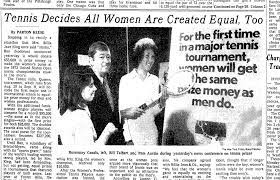by Randy Walker
@TennisPubisher
Parton Keese with the New York Times had a clever lead sentence in his article from July 20, 1973 when equal prize money was announced for the first time at the U.S. Open tennis championships.
It also couldn’t have been a better marketing tag-line for Ban Deodorant as well.
Wrote Keese, “Stepping in to rectify a situation that Mrs. Billie Jean King once said “stinks,” Ban deodorant announced yesterday it would donate $55,000 in prize money to make the women’s purse at the 1973 United States Open tennis championships equal to the men’s”.
And with what was called a “sports grant” from Ban, a subsidiary of Bristol‐Myers, the deficit in women’s prize money against men’s prize money at the U.S. Open was made whole and the U.S. Open became the first tennis tournament – and major sporting event – to offer equal prize money to men and women. Besides its obvious social significance, it was also an amazing publicity and marketing campaign for Ban and Bristol-Myers.
Joseph G. Kelnberger, vice president of Bristol‐Myers Product Division, was quoted by Keese saying his company agreed with Billie Jean King and her fellow female tennis pros saying: “We feel that the women’s game is equally as exciting and entertaining as the men’s, and we hope that our direct involvement with the 1973 U.S. Open clearly indicates our positive position on behalf of women in sports.”
There was a press event to announce this historic occasion at the famed but now permanently-closed “21” Club at 21 W 52nd St in New York. Rosie Casals represented women pros at the event with Chris Evert calling in from Fort Lauderdale. Billie Jean King was out of the country and not available. The previous year, King won only $10,000 for winning the 1972 U.S. Open women’s singles title while the men’s winner, Ilie Nastase, won $25,000. In 1973, Margaret Court and John Newcombe each won $25,000 for winning the women’s and men’s singles titles respectively.
Keese asked U.S. Open Tournament Chairman Bill Talbert if he thought that male players at the time would have a problem with women earning the same as men. Talbert responded, “I don’t know. If there is, I’ll just tell the men to go out and sell their product better.”
Incredibly, the U.S. Open was the only Grand Slam tournament to offer equal prize money to men and women until 2001 when the Australian Open also followed suit. The French Open offered equal pay in 2006, followed by Wimbledon in 2007.
The U.S. Tennis Association and the U.S. Open announced on March 14, 2023 on National Equal Pay Day, a nine-month promotional program that will feature “a number of significant events and a multi-media campaign that will cross linear, digital, and social media channels” that will promote the 50th anniversary of this important sports and social event. The USTA also announced that it is planning “a full slate of activities to support this historic anniversary stating “A multi-dimensional history of equal prize money, and the impact that equal prize money has had on sports will be launched online with additional promotion across the association’s social media channels. The series will include stories written by noted tennis journalists complemented with historic video footage which will roll out over the five months leading to the 2023 US Open. Finally, a “What Equality Means to Me” series of essays penned by notable women from all disciplines of life, will begin to roll out in April. The first of these essays will be authored by King. Equal prize money will be themed throughout the 2023 US Open and equality will be the focus of the US Open’s ongoing “Be Open” campaign. Now in its fourth year, the Be Open campaign emphasizes tennis’ commitment to diversity, inclusion and respect, and encourages all tennis fans to embrace these ideals.”

